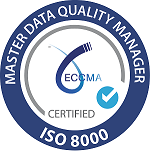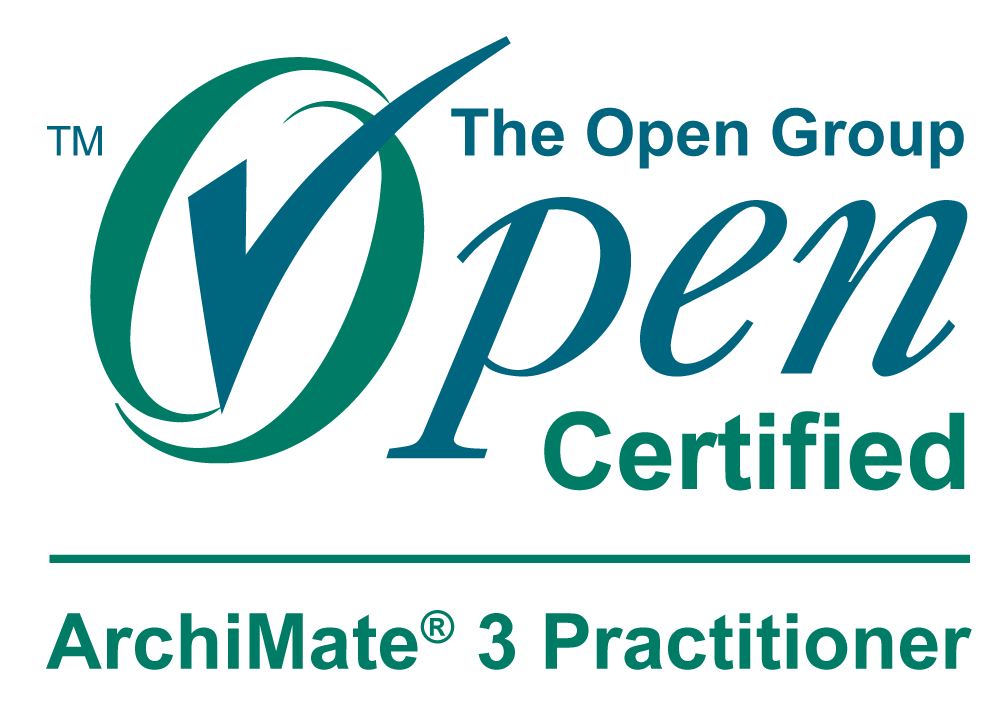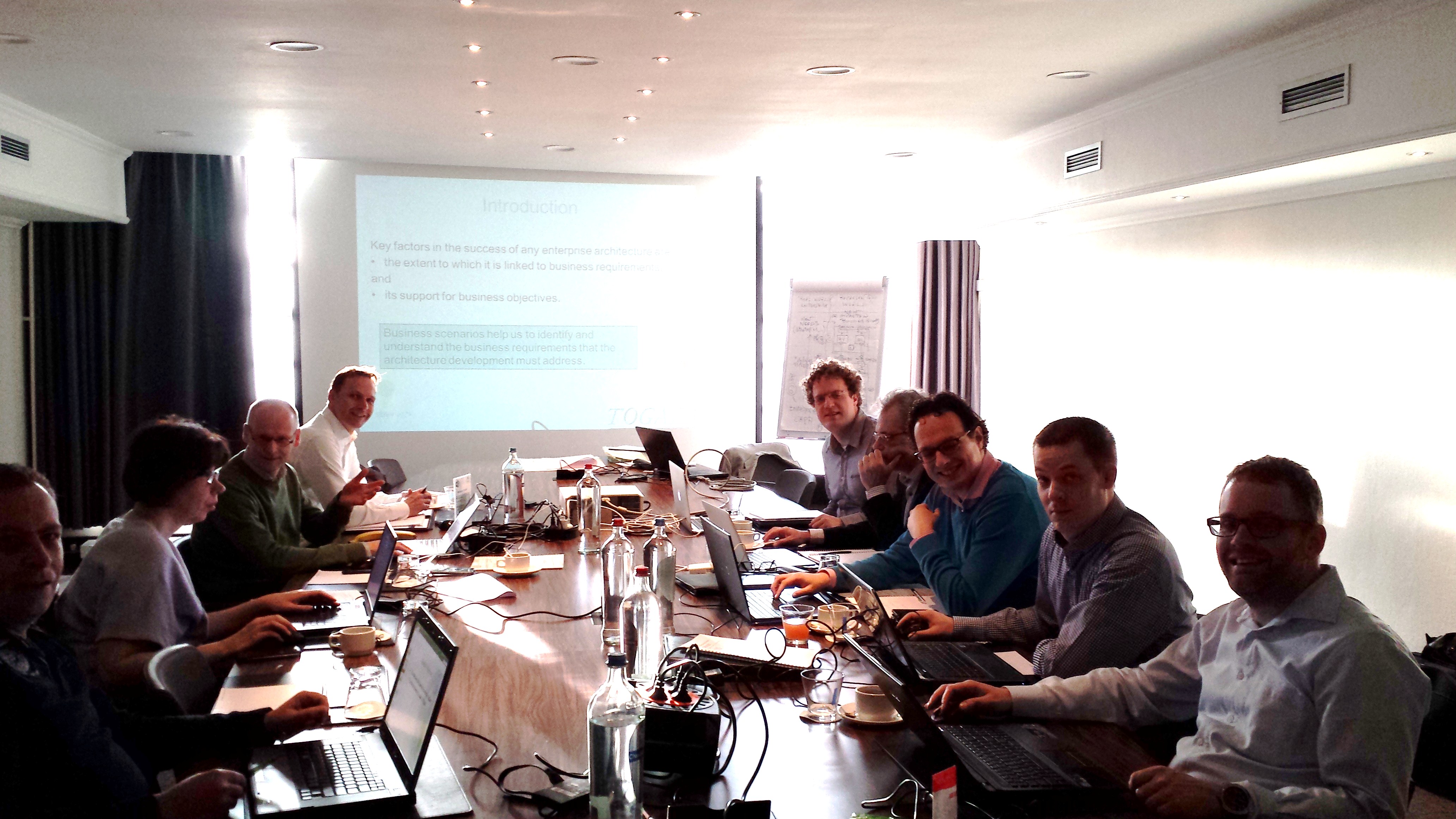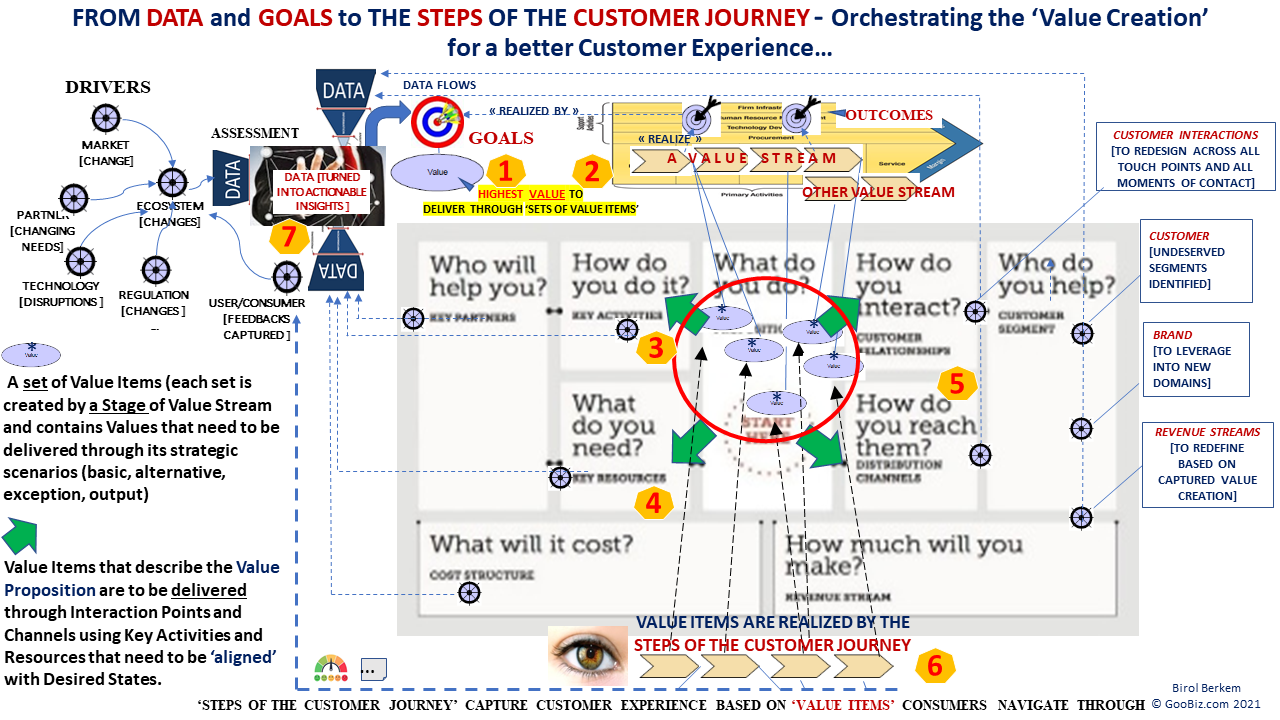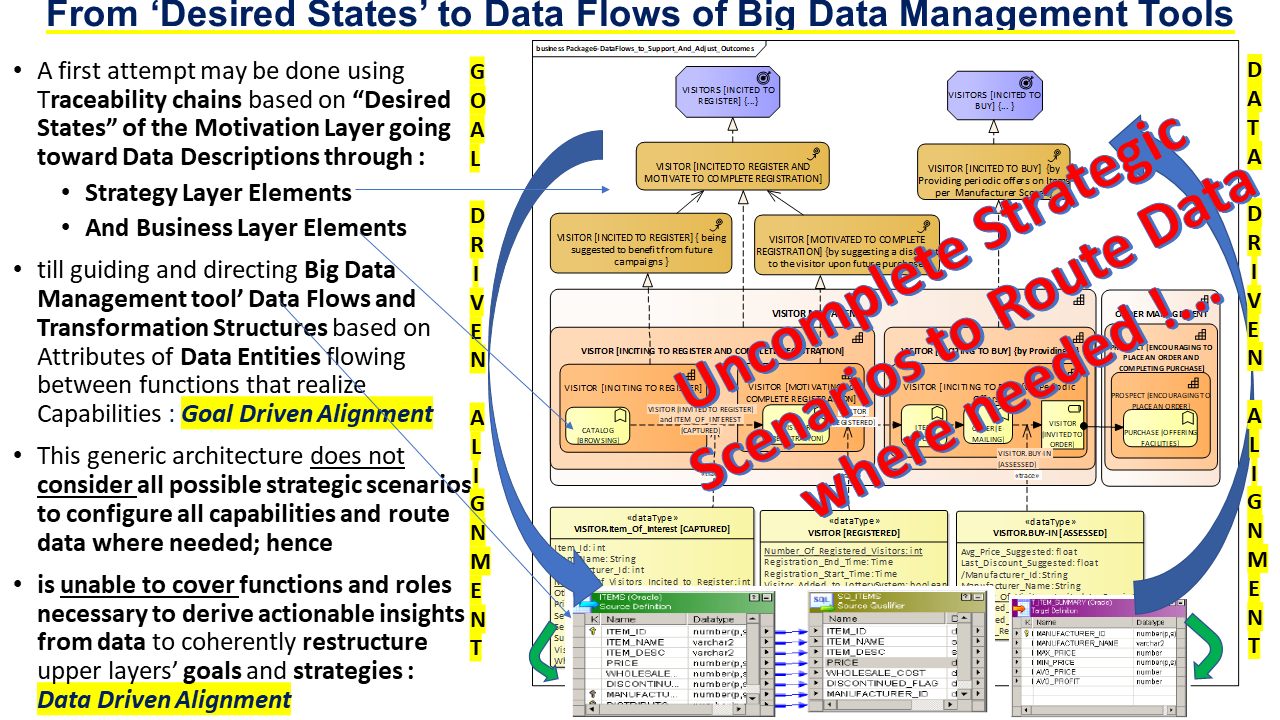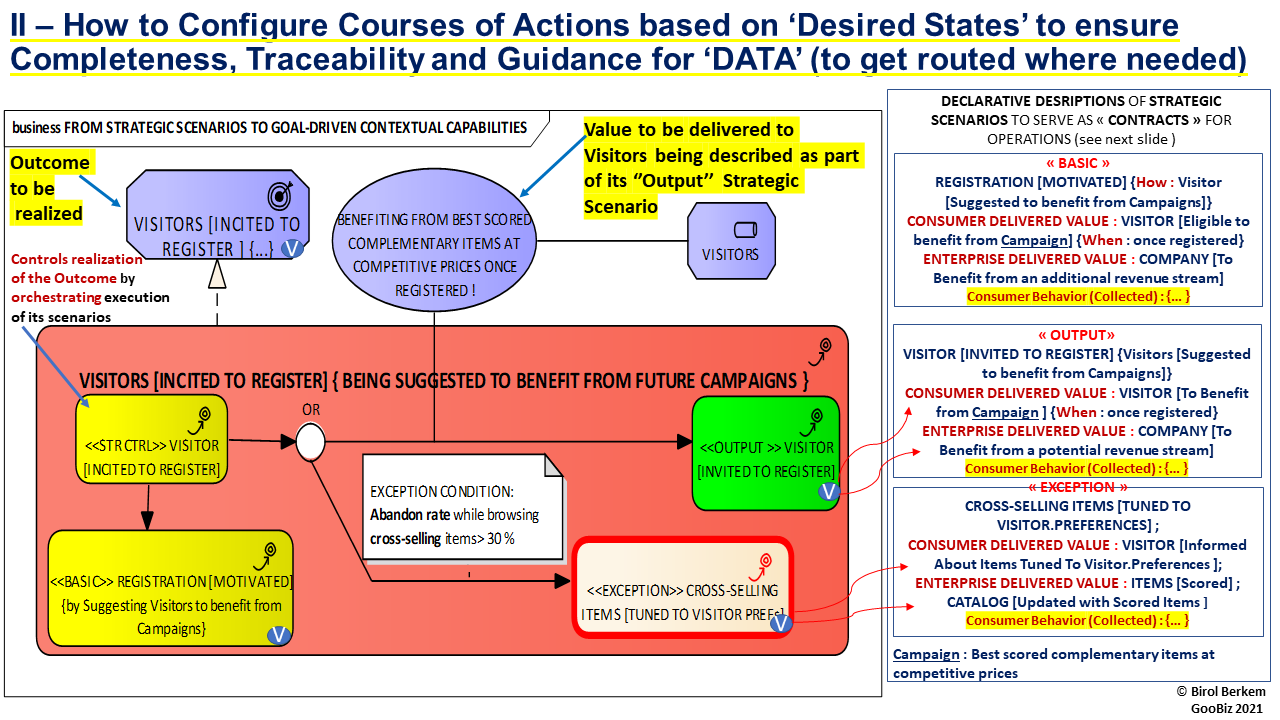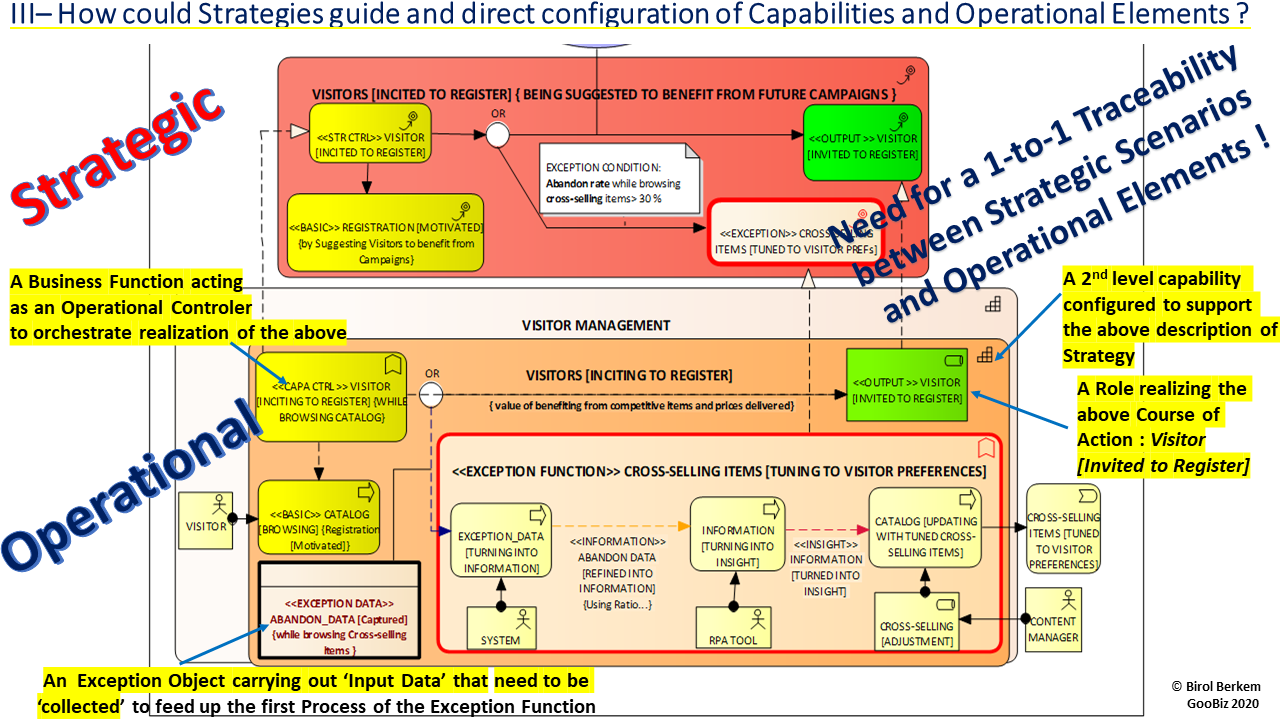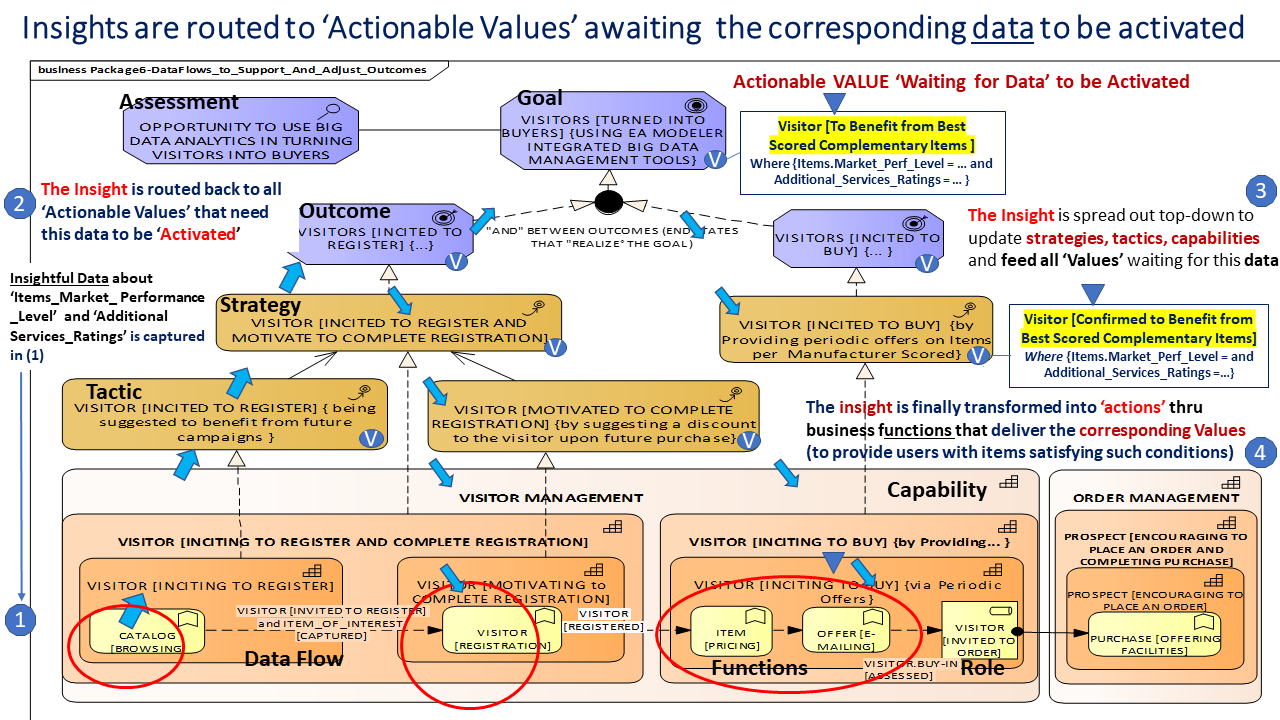Data-Driven Digital Transformation : From Goals to Actionable Insights for an End-to-End Value Delivery
IMPLEMENTING THE DATA-DRIVEN and GOAL-BASED VALUE DELIVERY FRAMEWORK USING ARCHIMATE 3
As the pace of disruption is dramatically continuing to increase with the 'new normals' of the COVID-19 crisis, companies need to use more than ever 'Data and Goal Driven Digital Transformation' approachs to deal rapidly and cost efficiently with disruptions in their business environment. This includes creating and delivering personalized value facing changing regulations, needs and habits of consumers and employees...
Consequently, flexibility and coherent adaptation to changes at all levels in the enterprise becomes the new "principle" and this needs to be accompanied by the right "information" and insight routed where needed in the enterprise ecosystem to quickly adapt the latter to its disruptive environment.
To align the "data collection" process with high-level goals then "route the 'insightfull information' to the right actors" for decision-making while supporting appropriate value delivery to their clients, organizations need a well-established synergy by combining their Enterprise Architecture and Data Architectures that were separately treated until now.
The resulting "Data-Driven and Goal Based Value Delivery Approach" aims to deliver a system architecture able to evolve rapidly and in coherence with changes that occur in its environment. To realize such a challenge, the approach constantly re-adjusts goals and underlying elements of the architecture being based on feedbacks captured from user and consumer behaviors including performance data captured from IoT systems.
To do this, the architecture elements from goals until operational data flows need to be treated in the same manner. They are assigned with appropriate responsibilities aligned to high-level goals that are constantly updated to deal with changes captured on environmental entities (competitors, regulations, technology,..., consumers ) that need to be constantly monitored.
Such a goal-driven assignment of responsibilities needs to operate on quickly reconfigurable architecture elements (from high-level goals up to operational data and insight that need to be routed to the right processes and roles) to deliver desired values.
In this perspective, to be identifiable and flexible against changes, elements of the architecture (goal, outcome, capability, process, ...) used to 'frame' the underlying ones need to be expressed each by specifying the entity that is to be monitored , the desired state that needs to be reached on this entity, means that have to be used or deployed to reach the desired state and finally the Value that are to be delivered to the recipients (consumers, employees, providers, business partners, ...).
A network of architecture elements where each element is formatted using such a formulation helps not only to closely align bottom-line structures of the architecture based on high-level goals and strategies ; it does also help in adjusting strategic elements of the architecture based on 'actionable insights' captured at the operational level. Such insights can be considered as new Means' in reaching these desired states.
The below schema depicts a compact representation of the steps of the 'Data-Driven and Goal Based Digital Transformation' process for an End-to-End Value Delivery as explained starting by figure 2.
Figure 1 : A high-level view of the cycle from Enterprise Goals to Customer Journey (steps 1 to 6) then going back to Assessments based on Customer feedbacks (step 7)...
Assessment of Customer feedbacks (collected as raw data) potentially require to derive insights to make them finally 'Actionable'.
A practical illustration to explain transformation of Data into Information then Actionable Insight is given in the following article entitled "Actionable Insights: The Missing Link Between Data And Business Value" by Brent Dykes who provides for his 'fitbit watch' the following visual examples of transformation Data -> Information - > Insights -> Action from left to right.
Below is provided a summary explanation of how to ensure such a Goal and Data-Driven Decision-Making by Aligning the Organization Structures and Operations with your Goals and Strategies.
The approach focuses on the 'Value Creation and Delivery' at each step based on the Innovation Dimensions -"The 12 different ways for Companies to Innovate (MIT Sloan) - https://lnkd.in/eqQdh_q until finally coming back to adjust Initial Strategies using Actionable Insights discovered based on Consumer Feedbacks.
Architecture Patterns referenced in each step of the below approach and some complementary metamodels are described with their dependency relationships on the following link :
Patterns_for_Data_Driven_Decision_Making_from_Goals_till_Actionable_Insights_in_an_
Agile_and_Learning_Organization
1) Structuring the Motivation Elements of the Organization to 'Align Roles, Processes and Data' with Desired States
APPLIED PATTERN : GOAL& DATA-DRIVEN VALUE DELIVERY (GDVD)
INTENT : Allowing assignment of a Value to Monitored Elements of the Architecture (from the Motivation Aspect to the Business Layer of ArchiMate 3). These elements are formulated by a couple of Entity and 'Desired State' able to control steps of delivery of the associated Value. Potential Means including constraints may also apply to this process of Value Delivery.
|
The figure below shows some essential Motivation elements of the Enterprise using association and realization relationships in respect to ArchiMate 3 Motivation Aspect MetaModel.
Elements used in designing the architecture have been formatted using :
- the Monitored Entity upon which the Desired State need to be achieved,
- the Means (constraints) that are planned to apply in reaching this target state
- and the Value that is to be delivered.
Figure 2 : Motivation Elements of the Enterprise formatted using a 'Monitored Entity ', 'Desired State', 'Means' and 'Value' formulation to Align underlying Organization Structures and "Data" with Desired States
The below figure shows a first attempt for an alignment from Motivational Outcomes (shown above) to Operational Data Flows through Courses of Actions (Strategies,Tactics) and Capabilities.
It focuses on the necessity to ensure completeness of Course of Actions to correctly configure underlying capabilities and route data where needed.
The Data-Driven Alignment on the basis of ETL and Data Analytics tools shown on the right help to adjust the decision-making.
2) Ensuring Strategic Completeness to 'Guide and Direct the Underlying DATA' where needed
As criticized in the above figure, strategies need to be described breadthwise to establish 'contexts' necessary to correctly configure capabilities and underlying operational elements such as Functions, Processes, Data Flows, Roles of the Organization Actors.
This means that every high-level strategy needs to embark within its description all possible scenarios that may be encountered during the realization of a Goal or Outcome ; each of them being formatted as a well-identified Goal-Driven Architecture Entity acting with Basic, Alternate, Exception or Output role.
APPLIED PATTERN : STRATEGIC & TACTICAL COMPLETENESS - (STC)
INTENT : Ensures completeness of strategic scenarios and traceability throughout description of corresponding Tactics in order to accurately configure underlying capability building blocks and operational elements in coherence
The figure below illustrates a more inclusive configuration of the strategy Visitors [Incited to Register] { being suggested to benefit from Campaigns...} (referenced in figure 3) with its contextual elements stereotyped that emerge in basic, exception and output paths.
They will serve in configuring Capabilities and underlying business layer elements of the organization using a one to one 'realization' relationship (cf. next step).
Business Values are implicitly linked to each of these contextual scenarios as shown here explicitly for the 'Output' scenario path.
An alternative 'text based declarative description' of each scenario is provided on the right. Being linked to each contextual scenario of the course of action, the attribute 'Consumer Behavior' has to measure how useful was the corresponding 'value delivery' to the consumer.
Figure 4 : Ensuring Completeness and Guidance for underlying DATA by expressing how Desired States can be realized using Courses of Actions that act as Basic, Alternate, Exception and Output Roles
Establishing a 1-to-1 relationship between strategy and operational layer elements augmented by 'delivered values' help to adjust stategies based on insights discovered at the operational layer (see step 4).
3) Configure Capabilities and Operations then get the Data routed to enable Insights
Let's see first the impacts of the Courses of Actions (Strategies and Tactics) in configuring Capabilities and underlying elements in two parts namely :
3.1 - Configure Capabilities and underlying architecture elements based on strategies and
3.2 - Directing the Data Flows on a Context basis and Turning Data into Insights
3.1) Configure Strategic Capabilities, Operational Processes and Roles
Courses of Actions that play different contextual roles (basic, alternate, exception, output) in a scenario description become each a kind of 'behavioral contract' to structure Capabilities and underlying business elements.
APPLIED PATTERN : ROUTING DATA TO CREATE VALUE - (RDV) - Part 1
INTENT : Allows Configuration of Architecture Elements based on Strategic Scenarios (1st. part : applied to Figure 5) and ensures data get routed where needed according to high-level goals and values (2nd. part applied on Figure 6)
The figure depicts how a collaboration of such course of actions (shown in the upper level) to realize the Desired States help to configure capabilities and underlying elements of the Architecture.
Figure 5 : Configuring Capabilities and underlying elements of the Architecture based on Strategic Scenarios
Indeed, capabilities formatted according to courses of actions help to structure underlying business layer elements they encapsulate where such elements have to realize strategic scenarios provided by basic, alternative, exception and output actions.
One of these business layer elements is the exception function Cross-Selling Items [Tuning to Visitor Preferences] shown in red on the above figure.
To realize the corresponding course of action Cross-Selling Items [Tuned to Visitor Preferences], this function focuses on different underlying processes of the Machine Learning Value Chain to explain how the "input data" represented by an exception data object on the left needs to be consumed by the first process to derive an "information" that is consumed in turn by a second process named 'Turning into insight' to finally create the expected output event Cross-selling Items [Tuned to Visitor Preferences].
Brief Story of the Processes inside the 'Exception Function'
The transformation of the input data into insights may be storied as follows :
On the basis of the visitor's actions on the website using the cursor of their navigation device, the system detects that the visitor is about leaving the webpage of the company where cross-selling items were displayed ; it then prompts the action of the visitor by displaying a pop-up inviting her to view alternative complementary items.
In parallel, the system conveys the collected data about the abandon event to the first process of the 'Exception Function' to compute the ratio of time spent by the user on cross-selling items vs. the time spent on browsing his/her items of interest.
Then based on the insight explaning that the 'abandon' may be due to insufficient or ill-linked cross-selling items to initial products already browsed by the visitor, the system displays to the visitor complementary cross-selling items recommended by the market excluding those that have already been suggested to the visitor according to her items of interests and provides the visitor with a final list of complementary items whenever he/she clicks "ok" on the displayed pop-up.
Finally based on 'visitor satisfaction' measured on changing intention of Visitors to stay more or less on the webpage or their buy-in, the system updates the catalog with scored complementary items then revisits the 'courses of actions' of the Architecture that were "subscribed to be notified" with such a collection of complementary items or based upon the decision of data strategist to create 'actionable insights' where appropriate (see step 4).
3.2) Directing 'Data Flows' on a Context basis and Turning Data into Insights using a Learning Value Chain
This step is split below in two parts : First "Directing the Data Flows to get the Right Information routed to the Right Role" then Turning Data into Insights to assist the Decision Making
3.2.1 Directing Data Flows to get the Right Data routed to the Right Role
APPLIED PATTERN : ROUTING DATA TO CREATE VALUE - (RDV) - Part 2
INTENT : Allowing Configuration of Operational Architecture Elements based on Strategies ( 1st. part illustrated Figure 5) and ensuring data to get routed where needed according to high-level goals and Values (2nd. part explained on Figure 6 )
This first part of that pattern aims at Identifing operational entities such as 'Role', 'Process', etc... that need to be named and assigned with appropriate 'Desired States 'according to their surrounding Capabilities.
Then its 'Part 2' presents a guidance to determine 'how to direct the right information' to the 'right role' under the control of Value Items structured according to strategies.
Consequently, data elements that need to be carried out by that data flow may be expressed as attributes of the corresponding Data Type (as also depicted in figure 3 for the nominal path using UML Data types mapped to a Big Data Analytics tool also explained for the exception path shown in figure 7 using notes).
An example of Operational 'Data and Role' Alignment to Strategic Values being guided by entities of the Innovation Dimensions is depicted below
Figure 6 : Getting Operational Data routed where needed based on Strategic Value Flows
Such a Strategic Guidance for 'Data' and Roles based on 'Desired States' ensures a streamlined flow of the planned value delivered throughout the Extended Enterprise.
The related Meta-Model of Reusable Architecture Building Blocks (from Goals to Data-Flows) is provided on : "Patterns for Data-Driven Digital Transformation : From Goals to Actionable Insights in a Learning Organization"
3.2.2 Turning Data into Insights to assist the Decision Making
APPLIED PATTERN :TURNING DATA INTO ACTIONABLE INSIGHTS - (TDAI)
INTENT : Allows the data collection process to be driven in respect to high-level goals and guides the Context based ML process steps in turning data into actionable insights to adjust strategies
We apply this pattern to understand how to collect the right data and turn them into insights using the Exception Function Cross-Selling Items [Tuning to Visitor Preferences] below.
Focusing on that Exception Function, emerging data attributes are shown on figure 7 below attached to Context based Data Flows to enable communication between Roles, Functions and underlying Processes.
On the left are shown the data elements that need to be collected at the execution time and injected in a Machine Learning Value Chain to derive typical information and insight.
Then the insightful data generated at the end of the process and attached to its output event as Prescriptive Actionable Insights are used to "notify" the Strategic Architecture Elements of the "Learning Enterprise" that were subscibed to such an event (due to their value to be delivered).
These strategic elements may also be discovered further by the data analyst by looking for the Right Contexts to make them Actionable (cf. Figure 9).
Figure 7 : The figure focuses on Attributes of Data to be collected and transformed being guided by Data Flows that contextually emerge in different Strategic Scenarios
Notice : Leaking Buckets represent places of the webpage where visitors leave.
If you feel uncomfortable with Modeling, you may alternatively use Declarative Descriptions of Data Flows based on Strategic Scenarios : https://www.goobiz.com/Declarative_Description_of_Data_Flows.html
Step 4 - Routing Insights and Assessing Consumer Feedbacks throughout the Architecture
APPLIED PATTERN : COHERENT DECISION-MAKING and EVOLUTION - (CDME)
INTENT : Ensures a coherent decision-making process and evolution by allowing appropriate revisions on strategies and tactics according to high-level goals, environment changes as well as feedbacks and insights captured through operational contexts.
This final step focuses on 'revising' strategies, tactics and capabilities based on potential user/consumer feedbacks and actionable insights discovered through step 3.
The objective is helping strategists and data architects understand 'appropriate strategic contexts' where an Actionable Insight might be created with all its due impacts on capabilities and underlying roles, processes and data flows that contribute to realize the adjusted strategies.The question that may assist such a decision-making is to ask :
" when an insightful data has been discovered at the operational layer (for example as part of the steps of the Customer Journey), what are the strategic elements of the architecture that can make it an 'actionable insight' to enable underlying operational processes realize the appropriate action- thus create an aligned appropriate value to the organization environment ?"
Indeed, while navigating through the model in the ascending direction an insight discovered in the context of a given operational process can be hosted within the 'values' attached to different strategic nodes (courses of actions) according to their due alignment with high-level motivation elements (goals, outcomes,...).
Operational Processes (including Steps of the Customer Journey) that realize such strategic nodes may then be 'subscribed' to such an insightful event in order to be 'notified' by the corresponding 'insightful data'.
Incorporating the 'Actionable Insight' within the 'Value delivery'
The 'Desired State' of the hosting Value element and its node (Goal, Outcome, Course of Action, ...) can be extended if necessary while incorporating a potential actionable insight.
Also 'Means or Constraints' of these elements may need to be updated to take this insight into consideration in achieving its objective.
The figure below shows how an insight discovered as part of the business function Catalog [Browsing] needs to be 'spread out' to update all appropriate strategic nodes to become actionable.
During the first step of the Customer Journey where visitors come to browse the Catalog of Products on the company website, analytics revealed that abandons were mainly due to the fact that visitors are more likely interested in 'Better Scored Performant Complementary Items (with Score level = 4)'.
Therefore such an insight needs to be routed back to all strategic nodes located in the hierarchy of the goal 'Visitors [Turned into Buyer] ' to align underlying Courses of Actions designed to deliver Value where it can become 'actionable'.
Indeed, in addition to ISO/IEC 2382 standard that allows to translate a data into information, an “insight captured on an object, such as facts, events, things, processes, or ideas, including concepts, looks for an appropriate 'Value context' within which it may become actionable”.
For example, strategic nodes that suggest a Value of 'Benefiting from Complementary Items' to Visitors provide an excellent ‘Value Context’ to host {Items [Scored Performant] Level = n}.
Such an informational update of strategic nodes imposes to processes that realize them to get ‘notified’ with the required data (‘a collection of Complementary Items with Performance Level Score = 4’).
Operational Processes including Steps of the Customer Journey are now able to suggest the corresponding data to visitors through their contextual scenarios (basic, alternate, exception or output) to serve the top level goal (or raison d'être) within which they become meaningful.
Figure 9 : Spreading Consumer Data Feedback throughout the Stategy Layer to make corresponding Values 'Actioned'
Circles depicted in red in top-down direction indicate :
- Strategic Values delivered by goals and courses of actions that need to be reconfigured to make captured insights actionable,
- Operational elements (Steps of the Consumer Journey) that are required to implement them.
Conclusion and Perspectives
Business Agility - the ability of a business to adapt rapidly and cost efficiently in response to changes in its environment requires :
- "routing appropriate information" to the "right actors" being aligned with Enterprise Goals and Strategies,
- adjusting the decision-making on the basis of all types of change including those captured through Steps of the Customer Journey
To align the "collection of operational data" with high-level goals and strategies then route the appropriate data to the right actor, the traceability chain from goals, strategies till business functions, processes and roles up to underlying 'data' need to be configured using a " Data-Driven and Goal-based Value Delivery" mindset.
Such an approach ensures traceability from 'desired states' of the enterprise up to underlying data that need to be collected, processed and routed to appropriate roles while supporting new insights that need to be considered in decision-making to become actionable.
Notice : Different models exposed along steps of the Goal & Data Driven Architecture are intended to be used by business and enterprise architects or system architects especially in the domain of System Engineering (Robotics, Artificial Intelligence, etc...)For non-technical business owners, these models can be transformed in text based Declarative Descriptions : https://www.goobiz.com/Declarative_Description_of_Data_Flows.html
---
The 'Data-Driven & Goal-Based Digital Transformation' is enabled by the Open Group's Open Agile Architecture O-AA
Detailed information about these concepts through practical exercices of a case study is provided as part of the below course description : "Data_Driven_Digital_Transformation-Guiding_the_Big_Data_to_Strengthen_the_Decision_Making"
